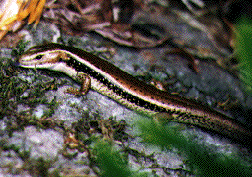
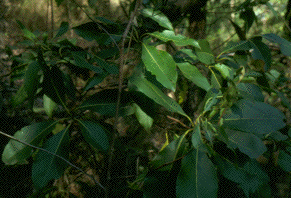
To help get acquainted with some of the environmental questions and field techniques that would be important throughout the program, on the second day of classes (24 September 1996), there was a half-day field trip to Brisbane Forest Park. Professor David Yates and his graduate assistant James Walle led the group through a series of data collection exercises that focused on plant structure, the variability of light intensity, and ground cover. Late in the afternoon, we hiked up to the lookout atop Mt Coot-tha. Even though there was a haze over the city, the view was still spectacular.
Professor Yates provided some background information on the park. He noted that: "Brisbane Forest Park is a large expanse of publicly held land which includes National Parks, picnic grounds and a water reservoir. It stretches from within 7 kilometers of the heart of Brisbane to a distance of about 40km away. As well as being the site of several local television transmitters and communications towers, Mt Coot-tha includes numerous picnic and other recreation facilities and is the nearest part of Brisbane Forest Park to the city. Mt Coot-tha has an elevation of 218m and is a 10-minute drive west of the University of Queensland. There is currently a proposal before Brisbane City Council for the development of a large tourist and shopping complex near the summit. At the moment there is a souvenir shop, a restaurant and a more casual cafe overlooking the city.
"Coot-tha is an aboriginal word referring to the place of wild bees and the small, black and stingless native bees Trigona are still common in the area. There is a good view of the city of Brisbane from the top of the mountain, and it is a popular place with young people at night as the lights of Brisbane twinkle below!"
On a clear day, you can see the distant line of Moreton and Stradbroke islands, the Glasshouse Mountains to the north, the mountains behind the Gold Coast to the south. There are several nice trails around Mt Coot-Tha and its foothills, such as the one to JC Slaughter Falls starting on Simpson's Rd.
The Mt Coot-tha Botanic Gardens, at the foot of the mountain, have an enclosed tropical dome, an arid zone, rainforests, and a Japanese garden. The Sir Thomas Brisbane Planetarium, the largest in Australia, is also located in the Botanic Gardens.
During the data collection exercises, there was a continuous humming in the background. We eventually realized that this was the sound of thousands of the stingless bees after which Mt Coot-tha is named.

Phylum: Chordata Class: Reptilia Order: Squamata Species: Eulamprus tenuis "Bar-sided skink"Body length 6.5 cm, tail length 15.5 cm. The bar-sided skink is can be seen in garden rockeries and moist forest habitats. They are active in sunny and shaded areas. Skinks like this one can be seen at Brisbane Forest Park and in and at other locations around Brisbane.
(Photo: J. Chiusolo '99)
While eating a lunch at the Peter's Pond picnic area in the park, we were visited by a number of birds.
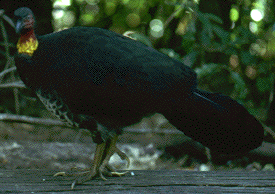
Class: Aves Order: Galliformes Family: Megapodidae Species: Alectura lathami "Australian Brush-turkey"The Australian Brush-turkey is a common sight in and around Brisbane and throughout eastern Queensland. Brush-turkeys are mound-builders or megapodes. With their stout legs, the males scratch up earth and leaf litter into large "incubators" where the female lays her eggs. The male tends the mound controlling its temperature by opening and or closing it. The mounds can be 4m across and 1--2m in height and contain a dozen or more eggs. Length: 59--70cm.
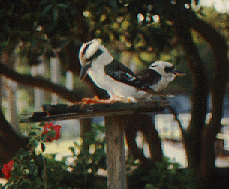
Class: Aves Order: Coraciiformes Family: Alcedinidae Species: Dacelo novaguineae "Laughing Kookaburra"The Laughing Kookaburra is the largest kingfisher. They have a loud, maniacal laughing call and often in "chorus." They feed mainly on reptiles and large invertebrates. The ones at Mt Coot-tha happily take bits of sandwich tossed their way. They are common in woodlands and forests in eastern Australia and are often seen in pairs. Length: 46cm.
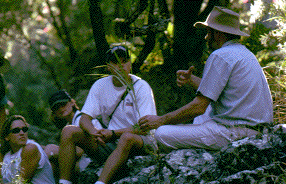 After the data collection exercises were concluded, we hiked to Simpson's Falls
to cool off and have a brief discussion with Professor Yates about what we had seen.
There a pair of sulphur-crested cockatoos, Cacatua galeria, squawked in the
trees overhead.
After the data collection exercises were concluded, we hiked to Simpson's Falls
to cool off and have a brief discussion with Professor Yates about what we had seen.
There a pair of sulphur-crested cockatoos, Cacatua galeria, squawked in the
trees overhead.
David Yates speaks to Brett Wood, Nancy Wheeler, and the rest of the group.
From the falls we hiked along the Eugenia Circuit out to main road by the television towers near the summit.
 At the summit at the end of the
afternoon, we spent time looking out over the city orienting ourselves to
Brisbane. Brisbane's central business district is less than 10km from the
summit.
At the summit at the end of the
afternoon, we spent time looking out over the city orienting ourselves to
Brisbane. Brisbane's central business district is less than 10km from the
summit.
Select two species of trees you can easily distinguish, including "brush box," Lophostemon confertus. Measure the circumference of at least 30 of each species (50+ would be better). Record circumference and immediately calculate DBH. Prepare a size-class distribution for each species and plot the results. Compare the distributions for the two trees. Do the shapes of the distributions tell you anything about the populations of these tree species? Are trees of one species larger than those of the other? What is a "big" tree in each of these species at this site?
Jerry Zolobkowski '97 measures the circumference of a brush
box tree at
Mt Coot-tha. Results of measurements on the north and south facing
slopes were compared.
Brush box can be found in contrasting habitats: on Stradbroke Island sand dunes, and (although it is not a rainforest species) we will also see it deep in the rainforest at Lamington National Park.
Student Data: Number of Internodes of Kangaroo Grass
Time: 2:20pm
Date: 24-9-96
Procedure:
| 13 | 9 | 14 | 7 | 10 |
| 12 | 6 | 5 | 11 | 10 |
| 9 | 7 | 8 | 6 | 5 |
| 14 | 4 | 7 | 12 | 10 |
How similar or different are the widths of the leaves between the plants of different sizes? What about the lengths? What can you say about ranges of leaf size or width for the species you have been looking at?
If there are relationships between the size of parts of an organism, are they the same for individuals of different sizes? For the largest plant, plot leaf length against leaf width. What is the relationship between these two measures of plant size? Add the data for the other two plants to the plot. Does the relationship you developed for the leaves of the large plant fit the data for the small plant?
Student Data: Measuring Lengths and Widths of Brush Box Leaves
Time: 2:50pm
Date: 24-9-96
Procedure:
| Small (Ht: 1.5m) | Medium (Ht: 2.5m) | | Large (Ht: 4.0m) | | |
| Length | Width | Length | Width | Length | Width |
| 10.1 | 5.2 | 15.0 | 4.9 | 13.9 | 7.6 |
| 13.7 | 5.4 | 9.6 | 4.7 | 14.1 | 7.7 |
| 13.4 | 5.1 | 12.1 | 4.2 | 14.2 | 8.0 |
| 12.8 | 5.9 | 13.1 | 5.5 | 14.3 | 6.1 |
| 12.0 | 4.9 | 10.2 | 5.0 | 12.2 | 6.2 |
| 15.2 | 6.7 | 12.9 | 4.8 | 12.8 | 7.4 |
| 11.6 | 4.8 | 11.7 | 5.1 | 14.9 | 7.6 |
| 14.3 | 5.4 | 12.6 | 6.0 | 14.3 | 5.9 |
| 13.8 | 4.9 | 12.2 | 6.5 | 13.3 | 8.0 |
| 10.6 | 4.0 | 14.8 | 6.3 | 15.2 | 7.4 |
| 12.2 | 6.2 | 11.5 | 4.2 | 14.1 | 7.7 |
| 11.3 | 3.9 | 16.8 | 6.1 | 13.3 | 6.2 |
| 14.1 | 6.0 | 11.7 | 5.1 | 14.5 | 6.4 |
| 11.5 | 4.6 | 11.4 | 5.2 | 12.4 | 6.8 |
| 8.5 | 2.4 | 14.8 | 5.3 | 14.3 | 7.4 |
| 11.7 | 4.1 | 12.6 | 4.7 | 13.7 | 6.6 |
At this site and at sites on Stradbroke Island, Lamington Plateau,
and elsewhere, you should estimate the proportion of incident
photosynthetically active radiation that is intercepted by the
plant community. This requires measurements above and below the
plant community, with adequate sampling to enable a reasonably confident
estimate to be made. At any site, there may be more than one canopy layer
for which you may make a measurement. For example, below the eucalypt
forest at Simpson's Falls there is a grass community in places. The
radiation transmitted (not intercepted) by the trees is available to
the grass. A measurement outside the forest and a measurement below
the forest allows a calculation of the proportion intercepted by the
tree canopy and that intercepted by the grass canopy.
Liz Brownold uses a quantum light sensor to measure photosynthetically
active radiation at Mt Coot-tha.
Student Data: Measuring Photosynthetically Available Radiation
Time: 3:25pm
Date: 24-9-96
Procedure:
Sophie Tashkovski '97 uses a quantum light sensor to measure light levels at
Mt Coot-tha.
| Up | Down | Up | Down |
| .546 | .800 | .220 | .172 |
| .578 | .655 | .480 | .391 |
| .166 | .823 | .715 | .136 |
| .810 | .577 | .592 | .149 |
| .692 | .615 | .615 | .116 |
| .223 | .694 | .277 | .582 |
| .563 | .692 | .309 | .120 |
| .167 | .618 | .510 | .123 |
| .113 | .578 | .771 | .102 |
| .771 | .766 | .538 | .351 |
Full sun reading: .364 @ 3:35pm
Every ten data points, measurement of full sun was taken.
Then someone picked a different place under plant canopy to
collect data. From the one reading to another, a distance of a
pace was travelled in order to cover a wide area under the tree/plant
canopy. This is all done in order to estimate the proportion of incident
photosynthetically available radiation (PAR) that is intercepted by the
plant community.